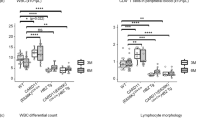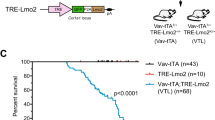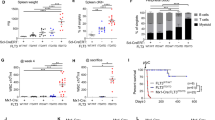Abstract
Evidence is continuing to accumulate that the FMS-like tyrosine kinase 3 (FLT3) receptor plays an important role in acute leukemias. Acute myeloid leukemia patients often express constitutive active mutant forms of the receptor in their leukemic cells. A t(12;13)(p13;q12) translocation between Tel and the FLT3 receptor was recently described in a patient with myeloproliferative disease (MPD). Here a Tel-FLT3 construct mimicking this fusion protein was used to generate transgenic mice. The fusion protein was previously found to constitutively activate FLT3 signaling and transform Ba/F3 cells. Expression of the fusion protein in the transgenic mice was found in all tissues assayed including spleen, bone marrow (BM), thymus and liver. These mice developed splenomegaly and had a high incidence of MPD with extramedullary hematopoiesis in the liver and lymph nodes. Spleens also had increased dendritic and natural killer cell populations. In vitro analysis of the hematopoietic progenitor cells derived from Tel-FLT3 transgenic mice showed a significant increase in the number of CFU-GM in the BM, and CFU-GM, BFU-E and CFU-GEMM in the spleen. BM also showed significant increases of in vivo CFU-S colonies. Thus, transgenic mice expressing constitutively activated Tel-FLT3 develop MPD with a long latency and also result in the expansion of the hematopoietic stem/progenitor cells.
This is a preview of subscription content, access via your institution
Access options
Subscribe to this journal
Receive 12 print issues and online access
$259.00 per year
only $21.58 per issue
Buy this article
- Purchase on Springer Link
- Instant access to full article PDF
Prices may be subject to local taxes which are calculated during checkout





Similar content being viewed by others
References
Gilliland DG, Griffin JD . Role of FLT3 in leukemia. Curr Opin Hematol 2002; 9: 274–281.
Levis M, Small D . FLT3: ITDoes matter in leukemia. Leukemia 2003; 17: 1738–1752.
Hannum C, Culpepper J, Campbell D, McClanahan T, Zurawski S, Bazan JF et al. Ligand for FLT3/FLK2 receptor tyrosine kinase regulates growth of haematopoietic stem cells and is encoded by variant RNAs. Nature 1994; 368: 643–648.
Nakao M, Yokota S, Iwai T, Kaneko H, Horiike S, Kashima K et al. Internal tandem duplication of the flt3 gene found in acute myeloid leukemia. Leukemia 1996; 10: 1911–1918.
Yamamoto Y, Kiyoi H, Nakano Y, Suzuki R, Kodera Y, Miyawaki S et al. Activating mutation of D835 within the activation loop of FLT3 in human hematologic malignancies. Blood 2001; 97: 2434–2439.
Clark JJ, Smith FO, Arceci RJ . Update in childhood acute myeloid leukemia: recent developments in the molecular basis of disease and novel therapies. Curr Opin Hematol 2003; 10: 31–39.
Drexler HG, Quentmeier H . FLT3: receptor and ligand. Growth Factors 2004; 22: 71–73.
Naoe T, Kiyoi H . Normal and oncogenic FLT3. Cell Mol Life Sci 2004; 61: 2932–2938.
Kelly LM, Liu Q, Kutok JL, Williams IR, Boulton CL, Gilliland DG . FLT3 internal tandem duplication mutations associated with human acute myeloid leukemias induce myeloproliferative disease in a murine bone marrow transplant model. Blood 2002; 99: 310–318.
Grundler R, Miething C, Thiede C, Peschel C, Duyster J . FLT3-ITD and tyrosine kinase domain mutants induce 2 distinct phenotypes in a murine bone marrow transplantation model. Blood 2005; 105: 4792–4799.
Lee BH, Williams IR, Anastasiadou E, Boulton CL, Joseph SW, Amaral SM et al. FLT3 internal tandem duplication mutations induce myeloproliferative or lymphoid disease in a transgenic mouse model. Oncogene 2005; 24: 7882–7892.
Kelly LM, Kutok JL, Williams IR, Boulton CL, Amaral SM, Curley DP et al. PML/RARalpha and FLT3-ITD induce an APL-like disease in a mouse model. Proc Natl Acad Sci USA 2002; 99: 8283–8288.
Schessl C, Rawat VP, Cusan M, Deshpande A, Kohl TM, Rosten PM et al. The AML1-ETO fusion gene and the FLT3 length mutation collaborate in inducing acute leukemia in mice. J Clin Invest 2005; 115: 2159–2168.
Ono R, Nakajima H, Ozaki K, Kumagai H, Kawashima T, Taki T et al. Dimerization of MLL fusion proteins and FLT3 activation synergize to induce multiple-lineage leukemogenesis. J Clin Invest 2005; 115: 919–929.
Gotze KS, Ramirez M, Tabor K, Small D, Matthews W, Civin CI . Flt3high and Flt3low CD34+ progenitor cells isolated from human bone marrow are functionally distinct. Blood 1998; 91: 1947–1958.
Small D, Levenstein M, Kim E, Carow C, Amin S, Rockwell P et al. STK-1, the human homolog of Flk-2/Flt-3, is selectively expressed in CD34+ human bone marrow cells and is involved in the proliferation of early progenitor/stem cells. Proc Natl Acad Sci USA 1994; 91: 459–463.
Gabbianelli M, Pelosi E, Montesoro E, Valtieri M, Luchetti L, Samoggia P et al. Multi-level effects of flt3 ligand on human hematopoiesis: expansion of putative stem cells and proliferation of granulomonocytic progenitors/monocytic precursors. Blood 1995; 86: 1661–1670.
Shah AJ, Smogorzewska EM, Hannum C, Crooks GM . Flt3 ligand induces proliferation of quiescent human bone marrow CD34+CD38− cells and maintains progenitor cells in vitro. Blood 1996; 87: 3563–3570.
Hirayama F, Lyman SD, Clark SC, Ogawa M . The flt3 ligand supports proliferation of lymphohematopoietic progenitors and early B-lymphoid progenitors. Blood 1995; 85: 1762–1768.
Broxmeyer HE, Lu L, Cooper S, Ruggieri L, Li ZH, Lyman SD . Flt3 ligand stimulates/costimulates the growth of myeloid stem/progenitor cells. Exp Hematol 1995; 23: 1121–1129.
Williams NS, Klem J, Puzanov IJ, Sivakumar PV, Bennett M, Kumar V . Differentiation of NK1.1+, Ly49+ NK cells from flt3+ multipotent marrow progenitor cells. J Immunol 1999; 63: 2648–2656.
Christensen JL, Weissman IL . Flk-2 is a marker in hematopoietic stem cell differentiation: a simple method to isolate long-term stem cells. Proc Natl Acad Sci USA 2001; 98: 14541–14546.
Matthews W, Jordan CT, Wiegand GW, Pardoll D, Lemischka IR . A receptor tyrosine kinase specific to hematopoietic stem and progenitor cell-enriched populations. Cell 1991; 65: 1143–1152.
Rosnet O, Schiff C, Pebusque MJ, Marchetto S, Tonnelle C, Toiron Y et al. Human FLT3/FLK2 gene: cDNA cloning and expression in hematopoietic cells. Blood 1993; 82: 1110–1119.
Tse KF, Mukherjee G, Small D . Constitutive activation of FLT3 stimulates multiple intracellular signal transducers and results in transformation. Leukemia 2000; 14: 1766–1776.
Golub TR, Barker GF, Lovett M, Gilliland DG . Fusion of PDGF receptor beta to a novel ets-like gene, tel, in chronic myelomonocytic leukemia with t(5;12) chromosomal translocation. Cell 1994; 77: 307–316.
Vu HA, Xinh PT, Masuda M, Motoji T, Toyoda A, Sakaki Y et al. FLT3 is fused to ETV6 in a myeloproliferative disorder with hypereosinophilia and a t(12;13)(p13;q12) translocation. Leukemia 2006; 8: 1414–1421.
Whartenby KA, Calabresi PA, McCadden E, Nguyen B, Kardian D, Wang T et al. Inhibition of FLT3 signaling targets DCs to ameliorate autoimmune disease. Proc Natl Acad Sci USA 2005; 102: 16741–16746.
Levis M, Murphy KM, Pham R, Kim KT, Stine A, Li L et al. Internal tandem duplications of the FLT3 gene are present in leukemia stem cells. Blood 2005; 106: 673–680.
McKenna HJ, Stocking KL, Miller RE, Brasel K, De Smedt T, Maraskovsky E et al. Mice lacking flt3 ligand have deficient hematopoiesis affecting hematopoietic progenitor cells, dendritic cells, and natural killer cells. Blood 2000; 95: 3489–3497.
Mackarehtschian K, Hardin JD, Moore KA, Boast S, Goff SP, Lemischka IR . Targeted disruption of the flk2.flt3 gene leads to deficiencies in primitive hematopoietic progenitors. Immunity 1995; 3: 147–161.
Lanzkron SM, Collector MI, Sharkis SJ . Hematopoietic stem cell tracking in vivo: a comparison of short-term and long-term repopulating cells. Blood 1999; 93: 1916–1921.
Levis M, Small D . Novel FLT3 tyrosine kinase inhibitors. Expert Opin Investig Drugs 2003; 12: 1951–1962.
Sternberg DW, Licht JD . Therapeutic intervention in leukemias that express the activated fms-like tyrosine kinase 3 (FLT3): opportunities and challenges. Curr Opin Hematol 2005; 12: 7–13.
Adams JM, Harris AW, Strasser A, Ogilvy S, Cory S . Transgenic models of lymphoid neoplasia and development of a pan-hematopoietic vector. Oncogene 1999; 18: 5268–5277.
Maraskovsky E, Brasel K, Teepe M, Roux ER, Lyman SD, Shortman K et al. Dramatic increase in the numbers of functionally mature dendritic cells in Flt3 ligand-treated mice: multiple dendritic cell subpopulations identified. J Exp Med 1996; 184: 1953–1962.
Shurin MR, Pandharipande PP, Zorina TD, Haluszczak C, Subbotin VM, Hunter O et al. FLT3 ligand induces the generation of functionally active dendritic cells in mice. Cell Immunol 1997; 179: 174–184.
Parajuli P, Mosley RL, Pisarev V, Chavez J, Ulrich A, Varney M et al. Flt3 ligand and granulocyte-macrophage colony-stimulating factor preferentially expand and stimulate different dendritic and T-cell subsets. Exp Hematol 2001; 29: 1185–1193.
Pulendran B, Lingappa J, Kennedy MK, Smith J, Teepe M, Rudensky A et al. Developmental pathways of dendritic cells in vivo: distinct function, phenotype, and localization of dendritic cell subsets in FLT3 ligand-treated mice. J Immunol 1997; 159: 2222–2231.
Wang A, Braun SE, Sonpavde G, Cornetta K . Antileukemic activity of Flt3 ligand in murine leukemia. Cancer Res 2000; 60: 1895–1900.
Esche C, Subbotin VM, Maliszewski C, Lotze MT, Shurin MR . FLT3 ligand administration inhibits tumor growth in murine melanoma and lymphoma. Cancer Res 1998; 58: 380–383.
Favre-Felix N, Martin M, Maraskovsky E, Fromentin A, Moutet M, Solary E et al. Flt3 ligand lessens the growth of tumors obtained after colon cancer cell injection in rats but does not restore tumor-suppressed dendritic cell function. Int J Cancer 2000; 86: 827–834.
Pisarev VM, Parajuli P, Mosley RL, Sublet J, Kelsey L, Sarin PS et al. Flt3 ligand enhances the immunogenicity of a gag-based HIV-1 vaccine. Int J Immunopharmacol 2000; 22: 865–876.
Smith JR, Thackray AM, Bujdoso R . Reduced herpes simplex virus type 1 latency in Flt-3 ligand-treated mice is associated with enhanced numbers of natural killer and dendritic cells. Immunology 2001; 102: 352–358.
Passegue E, Jamieson CH, Ailles LE, Weissman IL . Normal and leukemic hematopoiesis: are leukemias a stem cell disorder or a reacquisition of stem cell characteristics? Proc Natl Acad Sci USA 2003; 100 (Suppl 1): 11842–11849.
Acknowledgements
We thank Larry Witte of the Imclone Systems for providing the FL. We also thank all members of the Small laboratory for valuable discussions. DS is also supported by the Kyle Haydock professorship in Oncology. This work was supported by grants frm the NCI (CA70970, CA90668 and CA91177: DS), Leukemia and Lymphoma Society (DS).
Author information
Authors and Affiliations
Corresponding author
Rights and permissions
About this article
Cite this article
Baldwin, B., Li, L., Tse, KF. et al. Transgenic mice expressing Tel-FLT3, a constitutively activated form of FLT3, develop myeloproliferative disease. Leukemia 21, 764–771 (2007). https://doi.org/10.1038/sj.leu.2404532
Received:
Revised:
Accepted:
Published:
Issue Date:
DOI: https://doi.org/10.1038/sj.leu.2404532
Keywords
This article is cited by
-
Characterisation of FLT3 alterations in childhood acute lymphoblastic leukaemia
British Journal of Cancer (2024)
-
Myeloid/lymphoid neoplasms with FLT3 rearrangement
Modern Pathology (2021)
-
Fusion driven JMML: a novel CCDC88C–FLT3 fusion responsive to sorafenib identified by RNA sequencing
Leukemia (2020)
-
A novel t(3;13)(q13;q12) translocation fusing FLT3 with GOLGB1: toward myeloid/lymphoid neoplasms with eosinophilia and rearrangement of FLT3?
Leukemia (2017)
-
FLT3 expression and IL10 promoter polymorphism in acute myeloid leukemia with RUNX1-RUNX1T1
Molecular Biology Reports (2015)



